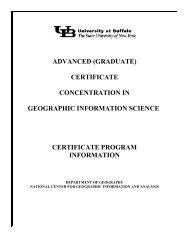Local Government GIS Demonstration Grant - NCGIA Buffalo
Local Government GIS Demonstration Grant - NCGIA Buffalo
Local Government GIS Demonstration Grant - NCGIA Buffalo
Create successful ePaper yourself
Turn your PDF publications into a flip-book with our unique Google optimized e-Paper software.
Needs Assessment 31<br />
Once all of this information is collected and analyzed for each department and published in a report,<br />
it can be used as a blueprint for implementing the <strong>GIS</strong>. The <strong>GIS</strong> coordinating group within the<br />
organization will use it to:<br />
• Design the <strong>GIS</strong> database<br />
• Identify <strong>GIS</strong> software that will meet the government's needs<br />
• Prepare an implementation plan<br />
• Start estimating the benefits and costs of a <strong>GIS</strong><br />
A common mistake in performing a needs assessment is to simply take an inventory of the maps<br />
and spatial data currently used in each department. There are two major problems with this<br />
approach. First, this does not allow the <strong>GIS</strong> coordinating group to evaluate how a <strong>GIS</strong> could be<br />
used to enhance the work of each department and the agency as a whole . By looking at the<br />
department functions and what the department does or produces, the <strong>GIS</strong> coordinating group and<br />
potential users develop an understanding of the role <strong>GIS</strong> can play in the organization. The existing<br />
data and maps do need to be inventoried and may well be used in building the <strong>GIS</strong>, however such<br />
an inventory should be separate from the needs assessment.<br />
The second major problem with the "data inventory" approach is that it tends to focus only on data<br />
internal to the organization. <strong>Local</strong> governments rely heavily on data from outside sources - federal<br />
agencies, state agencies, business, etc. The need for these data is better determined by looking at<br />
the potential <strong>GIS</strong> applications and how data will be used by each application. It can then be<br />
determined what data should be acquired from other sources.<br />
2 CONDUCTING A NEEDS ASSESSMENT<br />
The most significant aspect of a needs assessment is to document the findings in a standard and<br />
structured manner. It is very important to adopt (or develop) a standard method to be used for the<br />
description of all the <strong>GIS</strong> tasks, processes and data that will be included in the needs assessment.<br />
These forms will be used in needs assessment to identify the three kinds of <strong>GIS</strong> requirements:<br />
• <strong>GIS</strong> applications - these will be tasks that can be performed by the <strong>GIS</strong> when a user<br />
requires them, such as preparing a map, processing a query, or conducting some particular<br />
<strong>GIS</strong> analysis. <strong>GIS</strong> applications can be described using the five page <strong>GIS</strong> Applications forms<br />
included with this guide as Appendix A.<br />
• <strong>GIS</strong> activity - these are situations where information needs to be kept on some activity or<br />
process important to the user, such as issuing building permits, conducting public health<br />
inspections, etc. A <strong>GIS</strong> activity can be described using pages 1 and 4 of the <strong>GIS</strong> Applications<br />
forms - the main application form and the data flow diagraming (DFD) form.<br />
• <strong>GIS</strong> data - there will be certain categories of spatial data that are important to keep, but which<br />
will not appear in any <strong>GIS</strong> application or activity identified in any application description. A<br />
separate method must be developed to systematically record the need for such data. Other <strong>GIS</strong><br />
data needed but not included in either of the above categories, can be entered directly into the<br />
master data list.




